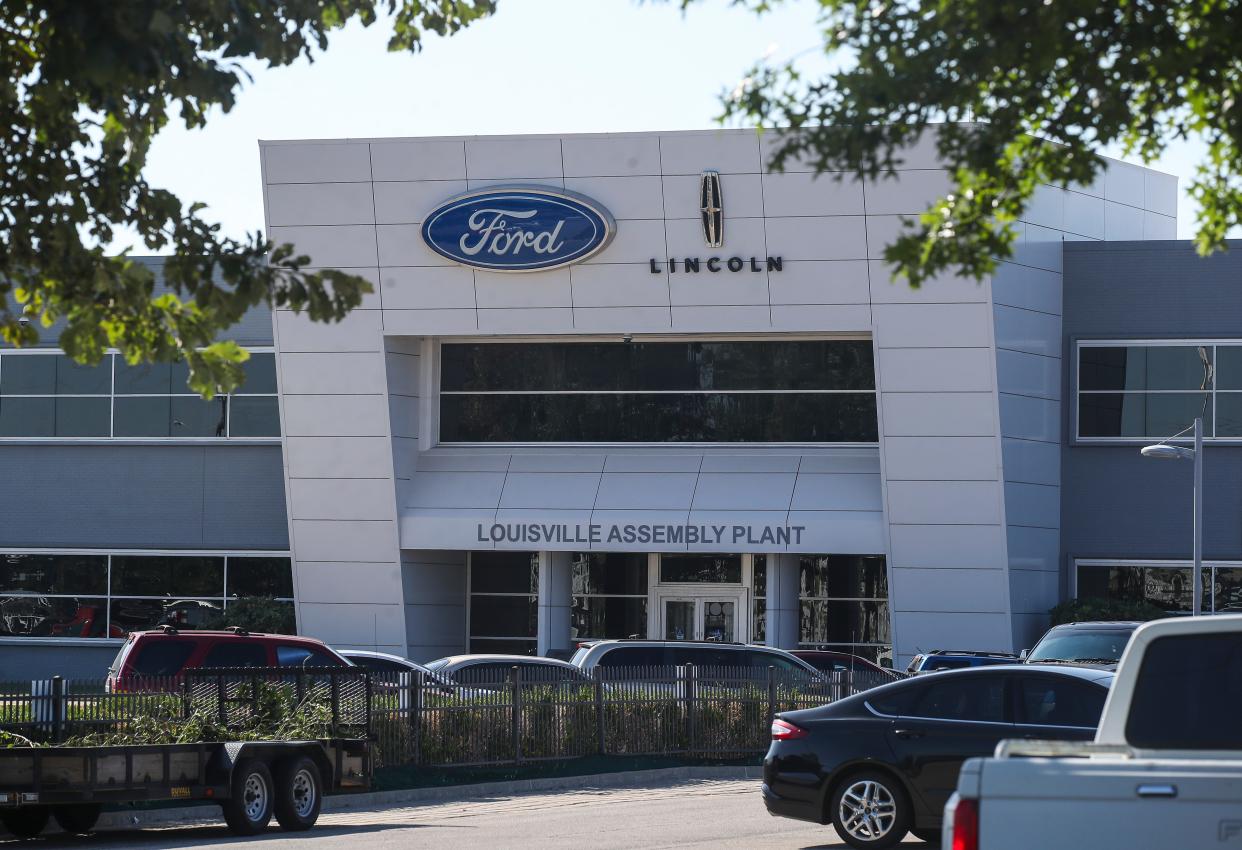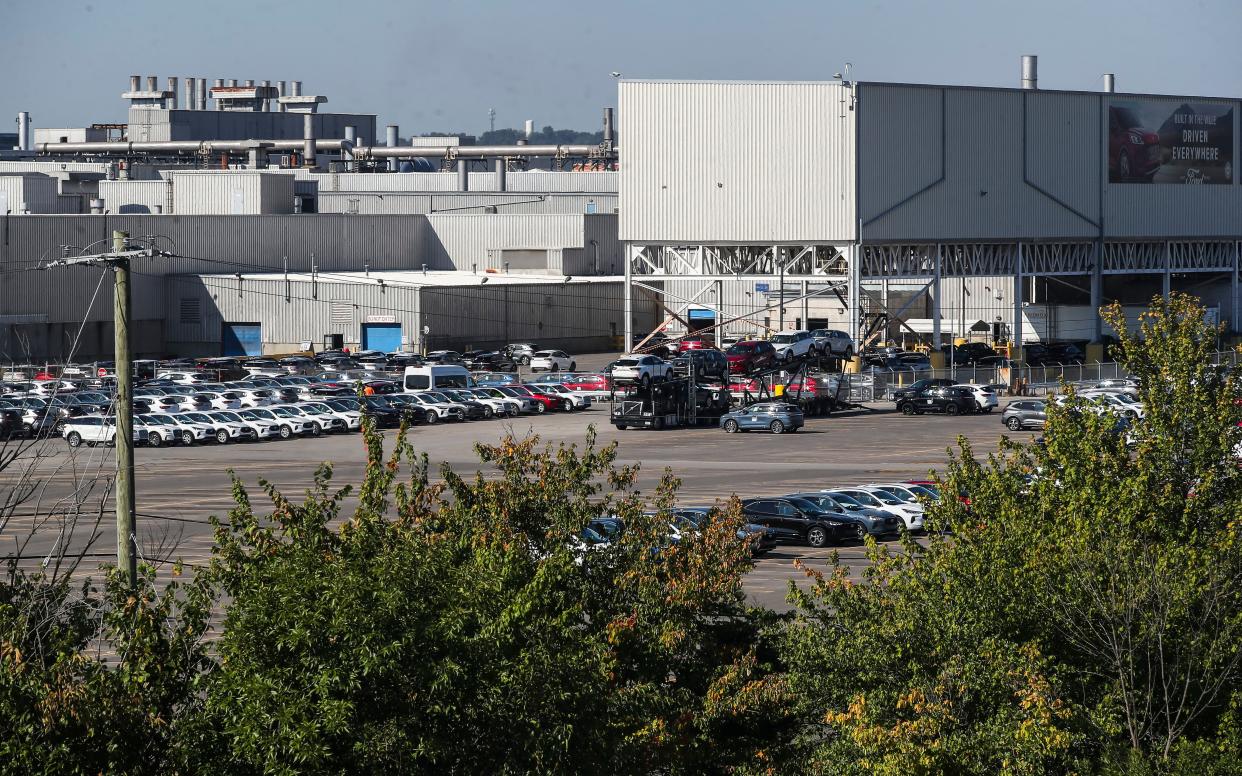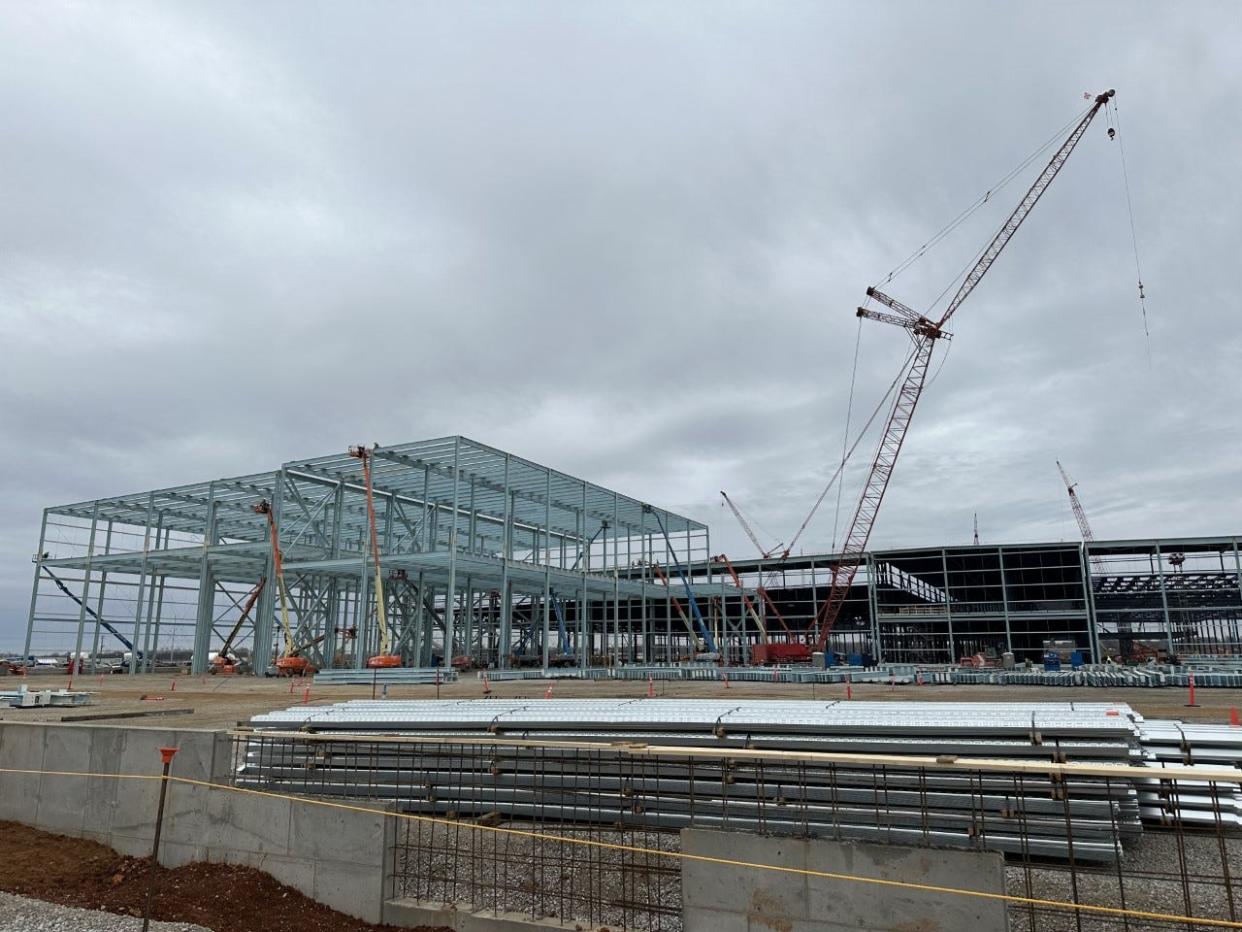How new UAW Ford agreement makes Louisville 'center of the universe' for electric vehicles
Driving past the Ford Kentucky Truck Plant on Chamberlain Lane, things appear to be back to normal.
The nationwide five-and-a-half weeklong United Auto Workers strike against Ford Motor Co. came to an end on Oct. 25 when the union and company reached a tentative agreement. Roughly 9,000 workers at KTP were on strike for two weeks before a deal was struck.
Now that the strike is over, workers have gone back to producing Ford vehicles, including the Super Duty truck, and are gearing up to vote to ratify the contract on Nov. 12 in Louisville.
But 22 miles across town at the smaller Ford Louisville Assembly Plant, things never changed. The plant on Fern Valley Road was never called to strike and workers continued to produce the Ford Escape and Lincoln Corsair, boasting some of its best months of production for both vehicles during the strike.
During the plant's 68-year history, LAP has often been in the shadow of Ford's $25 billion truck plant in Louisville, narrowly evading closure, seeing multiple work stoppages, experiencing changing product lines, and continually seeing consumer demand decrease for the products built there. Most recently, a Ford Labor Relations Bulletin from Nov. 3 announced LAP would experience temporary layoffs throughout the remainder of the month "due to parts related issues."
Despite these ever-growing challenges at LAP, Ford and the UAW have tentatively agreed to pump major investments and changes into the plant, giving it new life and helping set the tone for a transition to electric vehicle production, a continuation of Ford's plans in Kentucky, which include BlueOval SK, a more than $5 billion joint venture EV battery production park between Ford and SK On 50 miles south of Louisville.

"This new agreement is great news ... to see this kind of significant investment in our city's future is a testament to where our city is headed," Louisville Mayor Craig Greenberg told the Courier Journal. "Between this investment in LAP and what's going on at the BlueOval SK factory, Louisville is truly at the center of the universe for EV production and EV innovation."
According to the UAW and Ford tentative agreement highlights posted Oct. 29 by the UAW, LAP will receive a $1.2 billion investment over the life of the four-year agreement — the second largest product investment outlined in the tentative agreement — see the end of production of both the Ford Escape and Lincoln Corsair after 2025 and will transition to producing an "all-new EV product."
"We got a plant that's got security, we got a United States that's got the security of having a product, ... we've significantly increased the wages, we've got a contract that's the best contract we've seen in two decades," said President of UAW Local 862 in Louisville Todd Dunn.
UAW committed to getting 'job security' for members at Ford

At a practice picket on Aug. 25 at the UAW Local 862 union hall across from LAP, International UAW President Shaw Fain shared that it was a top priority for the negotiators to ensure the plant had a product commitment for the workers' future.
"Job security is one of our biggest issues, always is going into bargaining," Fain previously told media in Louisville.
Currently, LAP produces the Ford Escape and Lincoln Corsair, both of which have a planned product lifecycle through 2025. Dunn, who represents roughly 12,000 workers at both LAP and KTP, had previously said he would not endorse a new National Master Agreement that did not have a product commitment for both KTP and LAP.
"It's our job to bargain for products," Fain said previously. "The workers deserve product, I mean, the fruits of their labor, generate these massive profits. That's my expectation we have with the companies is that when new products come in, or when one product is going out, that we find a replacement for it and keep these plants going."
LAP is one of three assembly plants with a committed future EV product in the tentative agreement. Ford did not respond to the Courier Journal's attempts for comment about the possible LAP transition.
Greenberg said this transition to EV happening in Louisville "shows the country and world that Louisville is a great place for advanced manufacturing" and helps set the stage for future automotive advancements in the city.
"It's huge ... our main focus is to keep that plant open and running," Dunn said about the guarantee of a future product at LAP. "That's why I committed that I needed to have product in my plant and that I couldn't support, and I wouldn't support this agreement unless we have product in that plant."
'Fund the future'
In June 2022, Ford CEO Jim Farley alluded to the possibility of the end of the Ford Escape model as it currently exists saying, "Our job is to fund the future and we're going to have passion brands. We're not going to have commodity products like Edges and Escapes be Mustangs and Broncos and good stuff, and especially vehicles that don't suit themselves for BEVs [battery electric vehicles]."
"We want their work to be building a vehicle that we're deeply passionate about where the customers can't imagine life without it," Farley told media in Louisville in May in regard to the future of the Ford Escape and LAP. "So, I think they should be really excited about their future and they're going to continue to build really passionate products."
Kentucky Gov. Andy Beshear said creating a future for LAP and its workers has been a focus for him throughout his time as governor.
"I believe that securing the battery plant really cemented the fact that there was going to be a bright future at LAP," Beshear said in reference to the Ford BlueOval SK Battery Park which will begin production of batteries for Ford vehicles in 2025, just 50 miles south of LAP.
With the new tentative agreement creating a future of EV production in the state, Ford will now have the "whole lifecycle" of production for EVs in Kentucky.

Now, with the commitment of the second largest product investment across all U.S. Ford facilities, the future of LAP looks promising. Dunn said he previously suspected an EV product would come to LAP because Ford audited the plant recently, taking note of plant size and workforce operational space among other things.
EVs take fewer parts to assemble when compared to gas engine vehicles and can lead to workforce reductions, which was a concern of the UAW. However, Dunn said one thing working in LAP's favor is the floor space, roughly 3.1 million square feet of space.
"Cash is king, and in assembly plants, floor space square footage is key. That will give us more opportunities to engage in future possibilities for a total all-electric plant," Dunn said.
While he remains optimistic about future possibilities on the product line at LAP, Dunn said it is "on my radar" that the switch to electric production could lead to more layoffs. However, under the job security program tentatively agreed to between Ford and the UAW, there is an emphasis placed on protecting workers from the "unpredictable impact" the transition to EV may cause. The job security program would likely allow workers the chance to retain work at another Ford facility such as the BlueOval SK Battery Park in Glendale, according to the tentative agreement.
"I think the big thing is understanding how the process works, how much of our workforce is going to be affected, how to make sure that workforce is retained, and utilized in a different capacity, and be open-minded to how many other opportunities that we can take on," Dunn said.
History of Ford's Louisville Assembly Plant
LAP first opened in the metro in 1955, assembling trucks. By 1987, truck production had moved across town to KTP and LAP received a $260 million expansion and began producing the Bronco II. Just a few years later in 1990, the Ford Explorer rolled off the line at LAP, and the plant would assemble this SUV and enjoy success for the next decade with sales peaking at 445,157 in 2000.
In 2007, LAP was on the shortlist to be closed as Explorer sales decreased and rising gas prices impacted consumer buying habits. Later that year, the UAW agreed to a new contract with Ford that provided a commitment to keep LAP open.
Explorer production would eventually cease in 2010 and LAP saw a massive $631 million plant renovation. The next year, LAP reopened producing the Escape and by 2013 added production of the compact Lincoln crossover.
By the fall of 2018, Ford started to see a decrease in sales of the once-popular Escape, as competition from other brands in the compact SUV market grew. That same year also saw Ford move 550 jobs from LAP across town to KTP, as the demand for the Super Duty and other large SUV products continued to grow.
In 2019, Ford invested $550 million into LAP in preparation for the relaunch of the Escape, the Courier Journal previously reported. That year, the company also announced it would build the 2020 Lincoln Corsair, a compact SUV, at LAP.
During the pandemic, Ford, like many businesses saw plant closures and other points of infliction such as workers inside plants testing positive for COVID-19 as the company tried to continue producing vehicles while maintaining safety. In early 2021, as the pandemic continued to cause supply chain chaos, LAP saw work stoppages several times, delaying vehicle production.
Earlier this year, LAP once again experienced an extended temporary work stoppage fueled by quality control issues with the 2023-model Escape. Nearly 3,200 Ford assembly line workers were out of work for roughly four weeks, and vehicles were not produced during that time period as the company worked to fix a software issue.
Despite the plant's rocky past, LAP is poised to become a future leader in domestic EV production for Ford.
"Louisville has been a Ford Motor city, we still are a Ford city, and this agreement makes it very clear, we will continue to be a Ford city," Greenberg said.
Contact business reporter Olivia Evans at oevans@courier-journal.com or on Twitter at @oliviamevans_.
This article originally appeared on Louisville Courier Journal: Louisville Assembly Plant: What Ford's investment means for plant, EVs
